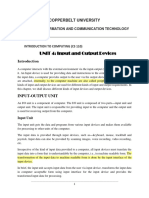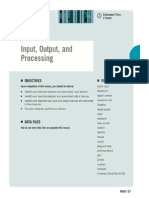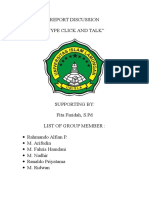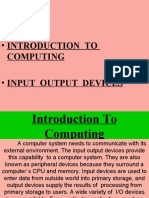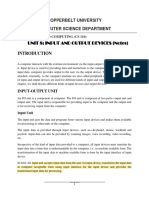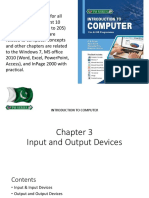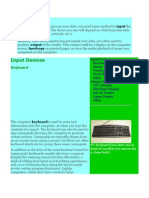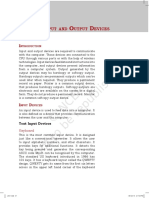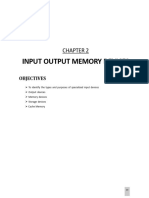0 ratings0% found this document useful (0 votes)
50 views13 pagesInput Output Devices
Input device
Uploaded by
januaryajit123Copyright
© © All Rights Reserved
We take content rights seriously. If you suspect this is your content, claim it here.
Available Formats
Download as PDF or read online on Scribd
0 ratings0% found this document useful (0 votes)
50 views13 pagesInput Output Devices
Input device
Uploaded by
januaryajit123Copyright
© © All Rights Reserved
We take content rights seriously. If you suspect this is your content, claim it here.
Available Formats
Download as PDF or read online on Scribd
You are on page 1/ 13
Curpter 9
Input-Output Devices
——— ee)
To be useful, a computer system needs to communicate with its external environment (its users). Input-output
devices (abbreviated 1/O devices) provide this capability to a computer system (see Figure 9.1). They are also
known as peripheral devices because they surround a computer's CPU and memory. Input devices enter data from
outside world into primary storage, and output devices supply the results of processing from primary storage to
users, Today, many types of /O devices are available. For an application, one type may be more suitable than
another type. Some /O devices perform both input and output functions. This chapter familiarizes the readers with
commonly used types of /O devices.
Input data —o} Input — ea >} Output | _+ Results of
rs devices Tnput data | spemory | Processed | devices processing
external coded in a in human
world ~ internal bier acceptable
form form form
Figure 9.1. llustrating the role of /O devices in a computer system
is because
Note tha} the speed of I/O devices is very slow as compared to that of primary storage and CPU: This - :
in spec
their speed in most cases depends on movement of mechanical parts, and the potential for improvement
of such ars is limited. I is, therefore, difficult to produce VO devices that ean match processor ‘and memory
Peeds, and there is a constant demand for faster and faster /O devices.
156 Chapter 9: Input-Output Devices
INPUT DEVICES
An input device is an electromechanical device that accepts data from Coe eae hem iy
form a computer ean interpret. Several input devices are # able today. We classify them broadly m0 Cg
categories:
5. Electronic cards based devices
1. Keyboard devices
devices
6, Speech recognition
2. Point-and-draw devices
7. Vision based devices
3, Data scanning devices
4. Digitizer
Various types of input devices along with their applications are described below.
Keyboard Devices
Keyboard devices are the most commonly used input devi
by pressing a set of keys (labeled buttons) neatly mountes
most popular keyboard used today is the 101-keys QWER’
ces today. They allow data entry into a computer sx
‘J on a keyboard connected 10 computer sysim Ti
TY keyboard (see Figure 9.2)
Point-and-Draw Devices
Initially, interaction with computers was restrict
aaa) that text-mode interaction is cumbersome, time-consuming, and limited in seo
Hence, computer designers came out with the idea of a new type of user interface, called graphical use"
(GUL). A GUI provides a screen with graphic icons (small images on the screen) or menus and allows &
tions from them to give instructions 10 a computer (see Figure 9.3). For efficient wilization,
ice with which a user can rapidly point to and select a graphic icon or menu ite fot
aye a renee hugh usable. inconvenient and unsuitable [2
search efforts to find a suitable input device 10 meet this requirement gave birth oy é
"track ball, joystick, light pen, and touch screen. Later designers realized «tt
(ed mainly to text mode. However, users and computer designe?
pe of Of
make rapid selec
san input devi
iple options displ
rement. Hence, res
mou:
mouse and light pen, are also useful for effectively creating graphic elements O°
nd freehand shapes. With this new ability, manufact
oe eerices. eee 'y. manufacturers and users of these de¥! en
hey puters a more easily usable tool, establishin
requ!
mu
put devices like
hese devices. like
nes, CUFVES, a
them point-and-di
such as
Input Devices | 157
versatile tool for a wide range of users including children,
Commonly used point-and-draw devices illiterate citizens, and graphic designers. Some
are described below
Menus
*
File Edit
View Image Options Help
Graphic icons
Figure 9.3. A graphical user interface (GU!) of Microsoft” Windows desktop.
Mouse
Mouse is the most popular point-and-draw device. It is a must
have input device on modern personal computers and
workstations because they support GUI as their primary user
interface. A mouse is a small hand-held device that fits
comfortably in a user's palm (see Figure 9.4). It rolls on a small
bearing and has one or more buttons on the top. When a user rolls
2 mouse (connected to a user terminal) on a flat surface, a
graphics cursor moves on the terminal screen in the direction of
the mouse’s movement. Since movements of the graphics cursor
on the screen reproduce all movements of the mouse, we can
easily position the graphics cursor at a menu item or an icon by
using the mouse.
Click buttons
Figure 9.4. A mouse
graphics cursor as different symbols such as an arrow (YO. a wrist with a
tion may also display the text and graphics cursor on the screen
Simultaneously. The graphics cursor, irrespective ofits size and shape, has a pixel-size point that is the point of
reference to decide the position of the cursor on the screen. This point is called hor spor of the graphics cursor
The graphics cursor points to a menu item or icon, when a user positions the hot spot on it. With a click of the
mouse’ button, a user can notify the system of this choice. Note that notifying the system of a particular choice
ut of the various options provided by software, is much easier with a mouse than pressing various key
combinations. With proper software, we can also use a mouse to draw pictures on the screen and edit text
Different applications display the
pointing finger (#"), etc. An applical
158 Chapter 9: Input-Output Devices
Commonly used ways to categorize mouse devices are
: e it that partially projeg
nd optical mouse. A mechanical moms as be ins a a ihe
through an opening in its base. The bal ols de wo surface fieun EN TSS he my
Mat surface, On two sides of the ball (at 90° angles from eA 1 On A the mouse ball ro
match the sped of he hall Each wheel f the mouse connects 1) 2 Soon: SF Te al a
user moves the mouse, the sensors detect how much each wheel spins WN Aah is nk
computer in the form of changes to the current position of the grap!
ma
lpi
in
5 Weng
on tie
ad, it has a built
An optical mouse has no mechanical parts like the ball and eels sHead howe, the win Phi.
detector. I comes with a special pad with gridlines-printed on it the pad, and sends this informer ”®
Pad, the photo-detector senses each horizontal and vertical line se ie cursor on inte cence talon jy
the computer in the form of changes to the current position of the grap! 8
2, One, two, and three buttons mouse. A mouse can have one, two, or three buttons. A one-button Mou
's good enough for programs designed to use only a single button. Some Programs Operate with a ty.
button or three-button mouse. If the system has lesser number of buttons, such programs can still runqy
the system by providing an alternative way to indicate a click of these buttons ~ such as by Pressing shif
Key on keyboard while the mouse button is clicked, With a mouse having multiple buttons, the leftmos
button is the main button that allows for most mouse operations because most people are right-handed anj
use their right index finger to click the main button, However, a user can configure another button as main
button. For example, a left-handed user can configure the right-most button as main button.
3. Serial and bus mouse, A serial mouse
plugs into a serial port (a built-in socket in a computer's back
Panel to which we can connect external devices). It does not require a special electronic card for
connecting the mouse to a computer. On the other hand, a bus mouse requires a special electronic card,
Which provides a special port just for connecting the mouse to a computer. The special electronic card fis
into one Of the expansion slots of the computer. Thus, a bus mouse occupies one of the expansion slot,
whereas a serial mouse does not need any expansion slot
Wired and cordless mouse. A wired mouse connects to a
other hand, a cordless mouse has no wired connection to a c
with the help of a special controller that operates by transmi
Although a cordless mouse is more expensive than a wi
mouse.
Computer with a small cord (wire). On he
‘omputer, It communicates with the computer
itting a low-intensity radio or infrared signal.
red mouse, it allows easier movement of the
Trackball
A trackball is a pointing device similar to a
along with the buttons (see Figure 9.5)
hand. As we do not need to move the wi
mechanical mo
To move the graphi
/hole device for Movil
use, Its roller ball is
ics Cursor on the scr
ing the graphics cu,
‘on the top (instead of the bas!)
Teen we have to roll the ball wit
than a mouse for operation, and is often atta
Trackball comes in various sha
button, and square. To move th
ball with fingers, or push the bu
‘Sand it
se eophics cmon ane [inetionaity. Three commonly used shapes a€ he
8 re
ton witha Finger, or simply ge 8 O9 the terminal screen, we have to roll |
'Y Move a finger on the square platform.
Trackball is a preferred device for CADICAM
(Com, i )
applications, because a designer can move the graphics ctor wind Oe Sign/Computer Aided Manufacture
Movements only without any movem™
Input Devices 159
equipment. This is more suitable to the style of working of designers and makes it easier for them to work
of
large drawings.
/ equipment having embedded computers also use a trackball. For example, an Ultrasound machine usually
Sever
has a trackball that kc
{hape) to mark the points of references on the image on the sereen.
1 sinologist (medical expert in sonography) uses to move the cursor (usually in eross-hair
Joystick
A joystick is a pointing device that works on the same principle as a trackball, To make the movements of the
spherical all easier, itis placed in a socket with a stick mounted on it (see Figurg 9.6). A user holds the stick in
hisher hand and moves it around to move the spherical ball. The user can move the stick forward or backward.
Jeftor right, 10 move and position the graphics cursor at a desired position. Most joysticks use potentiometers to
sense stick and ball movements, and a button on top of the stick to select the option pointed to by the cursor. The
user clicks the button to make this selection
Typical uses of a joystick include video games, flight simulators, training simulators, and remote control of
industrial robots.
+— Click bution
Light
indicator
-
Stick
Click butions
Ball is rolled.
with fingers
Socket
Figure 9.5. A trackball poveee Ae ae.
Electronic Pen
An electronic pen is a pen-based point-and-draw device. Its two commonly used types are:
1. Light pen. It uses a photoelectric (light sensitive) cell and an optical lens mounted in a pen-shaped case.
The photoelectric cell and lens assembly is in such a way that it focuses on,to it any light in its field of
View. Hence, when we move the tip of the pen over the screen surface, it detects the light emitted from a
limited field of view of the monitor's display. The system transmits this electric response to a processor,
Which identifies the menu item or icon that is triggering the photocell. In this manner, the graphics cursor
automatically locks on to the position of the pen and tracks its movement over the screen, The pen has @
finger-operated button, which the user clicks to select an option from the screen.
Computer-aided design (CAD) applications also use light pens frequently. For example, a user can draw
‘on the screen directly with a light pen. By using light pen with a keyboard, CAD applications allow users
a
160 Chapter 9: Input-Output Devices
awings, and add/erase graphics objCC% sy,
to select different colors and line thickness, reduce/enlarge drawings, and add/erase graphics OPJCC! suc
as lines, circles, rectangles, ete
a special type of writing pad. A uy,
a the computer. This in
vnever data he/she wants to input (0 7
are enables easy input of text and freehand drawings i
1 Digital Assistants) often provide this featuy
2, Writing pen with pad. This type of electronic pen comes with
writes on the pad with the electronic pen !
device with handwriting recognition software often
computer for word processing, Modern PDAs (Personal EO Te caesaeee
Moreover, aeciie ‘and messages stored and transferred as graphic images (like FAX messages) a
input with the use of this device. The image of the signature or Message Pike eaeirha ad
teeveval later or for transfer to another computer. Note that in banks, signatures 0” fa) oll ae
Stored in computers as images and retrieved by bank officials whenever ae ee
delivery organizations also use pocket computers with writing pen Bn et eee rie Ne Person
making deliveries uses this device to accept recipients’ signatures a8 inst their names in the compute
directly with the electronic pen, The device captures the image of a signature and stores it in the compute
for future references.
Touch Screen
Touch screen is the most simple, intuitive, and easiest to use of all input devices, enabling users (0 use a computer
without any formal training. It enables a user to choose from available options by simply touching with a finge
the desired icon or menu item displayed on a computer's screen.
Computers with touch screen facility use optical sensors, which can detect the touch of a finger on the screen
When a user touches the screen with a finger, the sensors communicate the position of touch to the compute,
Which interprets the input made by the user. Another touch screen technology is pressure sensitive monitors. In
this case, the system uses a flat pad located beneath the base of computer’s screen, which has highly sensitive
sensors to measure the prespure al many points. When a user touches the screen, the changing pressure transferred
down to the sensors allows the device to detect the location of touch. Obviously, the user needs to apply a litle
pressure at the point of touch to transmit the desired input to the system successfully
Information kiosks often use touch screens. An information kiosk is an unattended system located at a public place
that stores information of public interest and allows common people to access stored information as per theit
requirement, For example, information kiosks are often located: :
|. At an airport or a railway station to provide information to arri
arriving passe taurants;
tourist spots, etc. in a city. ig Passengers about hotels, rest
2. In large museums or zoos to guide the visitors tc
Be is 0 locations of va ene 10
cau various attractions and facilities, am
jon them against things they are not supposed to do while inside.
Ina large bank, post office, or insurance company to introduce various types of services to customers. and
to guide them to appropriate counters f i
for their specific Me
cinomers to cary oi teractions any POC JObS. Bank ATMs also use them to eh
4. In environments having dirt or weather condi
devices, 'er conditions, which prohibit use of keyboards and/or pointi"é
Data Scanning Devices
Data scanning devices are input devices that
seve Of them 1
also capable of recognizing marks or char some of them are
allow data ey
a Thee Entry from source documents direct!¥
Se devices have following characteris
Input Devices 161
1, They eliminate the need for manual entry of data by human beings, thus, improving data accuracy and
timeliness of the data processed.
2, Automatic entry of data with their use improves data accuracy and increases timeliness of the information
processed
3, They demand high quality of source documents because of direct data entry. Normally, they reject
documents typed poorly, having strikeovers, or having erasures. ‘
4, Form design and ink specification requirements become more critical with the use of these devices than
with the use of keyboard devices for data entry.
Commonly used types of data scanning devices are described below.
Image Scanner
‘An image scanner is an input device that translates paper documents into an electronic format for input to @
computer. The input documents may be typed text, pictures, graphics, or even handwritten material, This input
device is very useful in preserving paper documents in electronic form because a copy of a document stored in @
computer in this manner does not deteriorate in quality with age, «1 can be displayed or printed, whenever
desired, We can alter and manipulate the stored images in interesting ways, if the computer has image-processing
sofware
Two commonly used types of image.scanner are:
1 Flatbed scanner, A flatbed scanner is like a copier maiine consisting of a box having a glass plate on its
top and a lid that covers the glass plate (see Figure 9.7). To scan a document, a user has to place it upside
down on the glass plate. A light beam below the glass plate moves horizontally from one end to another
when activated. After scanning one line, the light beam moves up a little and scans the next line. The
process repeats until the beam finishes scanning the entire document. It takes about 20 seconds to scan a
document of 21 cm * 28 cm size
Hand-held scanner. A user can hold a hand-held scanner in hand conveniently (see Figure 9.8). It has a
set of light emitting diodes encased in a small case. To scan a document, a user drags it slowly over the
document from one end to the other end with its light on. The user must drag the scanner steadily and
carefully for correct conversion of the document into its equivalent bit map. Hence, those applications use
hand-held scanners in which high accuracy is not critical. Users also use them when they have to scan low
volume documents. They are much cheaper than flatbed scanners.
Optical Character Recognition (OCR) Device
We can use image si ety of d i
e image scanners to input a variety of documents including pictures, graphics, ty
handwritten text. a ee
When users use im i
W S age scanners for inputting text documents (typed or ha
limitations A oe indwritten), they face following
1. ‘Since scanned input document is stored as an image, instead of text, it isnot possibl
processing of the document (the computer cannot interpret the stored documentiny Iegeee oo a8 Word
special characters). as letters, numbers, and
162 | Chapter
Input-Output Devices
than that required fOr sor
mich more al gracters can be store
2. Storage space required for storing the docursent as an image lt 2g 2000 chet documnen
the same document as a text, For example, a page o printed tet DAN gg of the st
2000 bytes by using the ASCII representation. A bitmap-image PI ig W of grid point
require 100 15 times more storage depending on the resolution
“
aah
ood
aM
wo,
~~? S
; A hand-held seanner
Figure 9.7. A fiatbed scanner. Figure 9.8. 4 hand-held
this case, the scanner is equipped with character recognitis
software (called OCR software), which converts bitmap images of characters (0 equivalent ASCII codes. That is
the seanner first creates the bitmap image of the document and then the OCR software translates the array of grid
points into ASCH text that the computer can interpret as letters, numbers and special characters.
OCR technology overcomes these limitations. In
Fo translate bitmaps of characters into equivalent text, OCR software examines the bitmap of each character ani
compares with the pre-programmed set of characters, which the machine can recognize. Whichever charac
pattern it matches, or nearly matches, the machine considers it as the input character. If a scanned character doe
ter patterns, the OCR software rejects it.
not match satisfactorily with any of the stored char
OCR sofiware is extremely complex because it is difficult to make a computer recognize an unlimited number o
typefaces and fonts. Hence, their design enables them to recognize texts written using standard type fonts (called
ee fos) only om ne fonts are OCR-A (American standard) and OCR-B (European standard) (se
igure 9.9). Note that if the document contains italics or bold face letters, or f
7 "I , or fonts other tha e, which the
OCR software can recognize, the OCR software will not work effectively ete
Noland sede
OPARSTUVUXYZ
pT ae
LIP Pe ae
OT Shee
0123456789
eT ara
iN 8 ARES
(a) OCR-A fonts (American sta
standard)
: (b) OCR-B fonts (European standard)
Eas Ta
e220
Figure 9.9. Two stancara OCR fonts.
| Abar-code reader is a device for reading (decoding) bar-coded data. It is either a hand-he
Input Devices 16
Optical Mark Readér (OMR)
OME is a scanner, which can recognize a pre-specified type of mark made by pencil or pen. For exa
objective type tests applicants mark their choices of correct answers on a specia
darkening & small square, circular, or oval shaped box by a pencil (see
oan OMR device for grading with a computer automatically
pre-prinied test scoring sheet by
Figure 9.10). These
iswer she
The technique used by an OMR device for recognition of marks on a document involves focusing a light beam on.
the document and detecting the reflected light pattern from the marks, Pencil marks made with a soft lead pencil
(high graphite content) reflect the light strongly, enabling the OMR device to determine whigh responses are
marked.
For each question, four options are given out of which
only one is correct. Choose the correet option and mark
your choice against the corresponding question number
in the given answer sheet by darkening the corresponding
circle with a lead pencil.
Indicates direction in which the
1, Binary equivalent of decimal 4 is sheet should be fed to OMR device
(@ 101 (001
‘) Ut (a) 100
2. Full form of CPU is: =
(a) Cursor Positioning Unit ‘6 oe
(bs) Cental Power Unit fo Gg
(6) Ceniral Processing Unit
(@) Control Power Unit 20 0¢@0
ab a
3. Which isthe largest unit of storage among following
(a) Terabyte (c) Megabyte :
(b) Kilobyte —_(@) Gigabyte O° 9
(a) Question sheet (b) Pre-prnted answer sheet
Figure 9.10. A sample question sheet of an objective type test and its pre-printed
answer sheet, which is read by an OMR device to grade the test
Bar-Code Reader
Data coded in the form of small lines (known as bars) are known as bar codes. Bar codes represent alphanumeric
data by a combination of adjacent vertical lines (bars) by varying their width and the spacing between them, Atl
types of goods, books, postal packages, badges, tags, etc. use bar codes for unique identification purpose
Id or a stationary scanner
having barcode reader embedded ini. It seans a bar-code image and convents it into an alphanumerie veloc foe
input to a computer connected to it
A bar-code reader uses laser-beam scanning technology. It focuses a laser beam acr
s o se 08s the :
code. Different bar codes having different patterns of bars reflect the beam in differen: at bars of a bar
detector senses the reflected light patterns and converts them into electrical pulses, which they a ight-sensitive
‘© recognition logic circuits. Finally, the logic circuits convert the electrical pulses ints ey alphan then transmits
wumeri¢ Value.
——ao
164 “I
Chapter 9: Input-Output Devices
p ‘ode (UPC)
— rniversat Product Code (UPC,
Unie oducts, The UPC. which
well 08 MANY Tye UPC bar-code patterns
Th
here are many types of bar-coding systems. The most widely KA
nd the next five
It appears on almost all retail packages in USA and no
originally appeared on supermarket items, now appears on other ¢
decode as 10 digits. The first five digits identify the manufactiys) or SU
digits identity a specific product ofthe manufacturer (see Figure 912
f the product, #
7 roduct
tores, When a customer picks up a product for
ment stores:
fe ges a bar-code reader o
the sales person at the Orr yo an alphanumeric valu
ar code Mrory and sales records, and
rycpostal delivery services aso
USA uses 4 unique bar-coding
the current location of any
We often find bar code readers in supermarkets and depa
purchasing and brings it to the cash counter for payments
sean the bar code printed on the product. The bar-code reader COM dates j
and feeds it to a computer that looks up the price of the product, possibly ure
uses the price and description information to prepare a purchase bill for the coef
use bar codes to identify and tack each pa ‘ket. For example, Federal Express ole
system and their employees can usually tell a customer, within & matter of mH
packet
Product category character
0 grocery products
3 drugs and health [0
related products,
ete
21000 67520
\2iomy SE
™e
Manufacturer/supplier Specific product
identification number code number
Figure 9.11. An example of UPC bar code.
Magnetic-Ink Character Recognition (MICR)
MICR is similar to OCR. Banking industry uses it for faster processing of large volume of cheques handled every
act ins indus. A bank cheque has bank’ identification code (name, branch, ee.), account number, and
aa ey tuber pre-printed (encoded) on it by using characters from a special character set. The characters on the
cheque are pre-printed using a special ink containing particles of iron o: neti
5.12 shows a sample cheque that employs MICR technology. ride (having magnetic property). Figure
fas
© tezeneeh
Pre-printed MICR characters
Figure
912. & bank checiie that emnlavs MIR tachnalon™ di &
When a customer presents a filled-in cheque at a bank, a bank employee c snuall
supplied information including the amount written on the cheque. The
an MICR reader-sorter that can recognize magnetic ink characters. The MICR r i rier r ie printed
data on the cheques, and sorts the cheques for distribution to other banks, or for further processin:
E13B font is the most commonly used character set hy MICR de It consists of nume 0 to 9 and four
special characters (see Figure 9.13). An MICR reader-sorter transfers coded data in the form of these fonts from
cheques 10 @ computer. As the cheques enter the reading unit, they pass through a magnetic field causing
magnetization of the particles in the ink. Read heads then ir erpret these characters by examining their shapes
‘The sorter sorts the cheques into different pockets according to their identification code numbers
MICR technology speeds up data input for banking industry because with its use, banks feed their cheques
directly into the input device, which processes them automatically thereafter. Besides enabling faster processing
of cheques, this technology also ensures greater accuracy of data entry because of mostly pre-printed information
‘on the cheque and direct feeding of the cheques to the computer. However, other industries have not adopted
MICR because it has only 14 symbols (10 digits and 4 special characters). No alphabetic characters are available
Digitizer
A digitizer is an input device used for converting (digitizing) pictures, maps, and dra
input to computers. For example, x and y coordinates of points ina line drawin
This enables re-creation of the drawing from the stored information and eas
drawing, whenever required.
wings into digital form for
may be stored in digital form
incorporation of changes in the
A digitizer consists of a digitizing tablet (also known as graphics tablet) associated with a stylus (see Figure 9.14),
‘The digitizing tablet is a flat surface that contains hundreds of fine copper wires forming a grid. Each copper wire
receives electric pulses. The digitizing tablet easily spreads over a working table and connects to a computer. The
stylus is like a pen or a lens-like cursor with a cross hair and button. It connects to the tablet and a user can press it
down at a point on the tablet to input the (x, y) coordinates of the point. As a user moves the stylus on the tablet, a
cursor on computer's screen moves simultaneously to a corresponding position on the screen to provide visual
feedback to the user. This enables the user to draw sketches directly or to input sketched drawings easily
Inputting drawings or developing sketches by using a digitizer is simpler because it aulomaticall u
skeiched lines, arcs, ang other graphical objects as mathematically precise objects (like straight lines and smooth
curves)
b24L5 “
B° B40
i 1 NN
Wiha
Figure 9.13, £128 font (character sel) :
used by MICR devices. faure 9.14. A digi
inputs poorly
}
ee
ign (CAD) for de
engineers common! jpcal Information
medical devices, 1,
Ms also use them fo
Meet diitizers in the area of Computer Aided De
obots, mechanical pars, ete, Designers of Geom
" digitization of maps available in paper form
Electronic-carg Reader
: : 0a computer. Ey
Electronic cards and their associated readers offer another means of direc data entry int ae ey elect
eins re small plastic cards having encahea ‘ata appropriate for the application for which Ove use
Clecttonic-card reader, normally consecel gs Computer, reads the data encoded 0” :
‘ransers it tothe computer for futher procesing
Banks issue electronic cards to their customers for use with auomatc teller machines (ATI). Ao ATM iy
transactions machine connected to bank's computer, which alows 1 customer 10. pe form, cei
ATM haa nse MOUS a day without the need 0 interact witha bank employee, An electronic car for use in
creat Customer's account number and cred limi mann sour tha else. can withdioe ade
cans onthe card. An ATM has an electronic card reader associated with i, When a customer ince, a
saa ao the ATM (actualy the electronic-card eader ofthe ATM), the rade reads the date cocaded oye cz:
4o the bank's computer activating the customer's account. The customer then carries
Fre hcaowing the instructions displayed on the screen of the ATM and by pressing a fen i
on its customized keyboard or touch screen,
Speech Recognition Devices
beech recognition devices are input devices that allow a person to input data to a Computer systein by speak
to it, Hence, they make computers much easier to use, However, as a dan input device, currently spe
Monee in he recat Ne mited suéces because correct inerpreatin by a marine. y the large number
secre pranacabulary of a language is difficult. Major difficulties are that diese users speak with di
moaning proaunee difereny) and intonatons (with differen tone or pitch of ie voice), and the fact tha
meaning of a word varies depending on the context in which itis used. Hence, today’s speech recognition syste
ae limited to accepting few words within a relatively small domain and find usage in those applications, whi?
require speech input of limited kinds and quantities of data only
Although in its infancy,
already & wide-range of applications use speech recognition
applications are:
systems, Some o
1. For data input to a computer s
continuously look at a measu
room can request certain infor
2. For data input by dictation of |
yystem by a person in
ing instrument or so
mation about a patien
situations where hi
ome other abject. Fo
nt while operating
long text or passage for lat
sther hands are busy or he/she m8
or example, doctors in an ope!
er editing and review
? & Computer system based on speech input
by individuals with physical disabilities,
In addition to making input of data
user because the user is free to stan
to the system,
Hips noreeth recognition systems also provide freedom of movement
<¥P: Move around, or do some utes sok oy dad while mtg voice
visior
mit
lem
Acompy
given 00)
Vision-i
For exan
not mee
objects 0
OUTP
An outpu
Suitable |
into follo
Ly
2 *F
3 F
+s
xy
Various
Outpt
' s
s
u
Output Devices | 167
vision-Input System
case is normally an
4 vision-nput system allows a computer to accept inpat by seeing an object. Input data if this
of a human vision
A pat’ shape and features in the form of an image. The idea isto simulate the capability
Stem ina Timited sense,
lows the following steps to recognize 2
computer with a vision-input device consists of a digital camera and fol
given object
|, It focuses the camera on the given object to take its picture.
1, The camera creates a digital image of the object and feeds it to the computer.
You might also like
- Submitted By::Liayaz Ahmed Submitted To::Miss Sharafat BibiNo ratings yetSubmitted By::Liayaz Ahmed Submitted To::Miss Sharafat Bibi11 pages
- Ch-03 (Comp) - Input and Output DevicesNo ratings yetCh-03 (Comp) - Input and Output Devices60 pages
- Ch-03 (Comp) - Input and Output DevicesNo ratings yetCh-03 (Comp) - Input and Output Devices62 pages
- Chapter 4 Computer Input and Output DeviceNo ratings yetChapter 4 Computer Input and Output Device19 pages
- Chapter-4 Computer Input and Output DeviceNo ratings yetChapter-4 Computer Input and Output Device19 pages
- Pages From Basics of Computer-1 (BM1006-1) (1) - 2No ratings yetPages From Basics of Computer-1 (BM1006-1) (1) - 219 pages
- Input Output Memory Devices: ObjectivesNo ratings yetInput Output Memory Devices: Objectives22 pages










